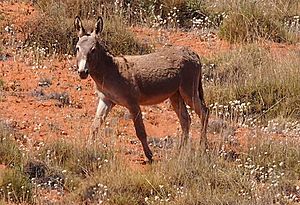Feral donkeys in Australia facts for kids
Feral donkeys are donkeys that live in the wild in Australia. They are not pets and they don't have owners. These donkeys first arrived in Australia a long time ago. People brought them to help carry things because horses were getting sick from some plants. Now, there are many millions of feral donkeys. Because there are so many, they cause problems for the environment. They can damage plants and make the soil wear away. People try to control their numbers, often using helicopters.
Contents
History of Donkeys in Australia
Feral donkeys are simply donkeys that have escaped from farms or work. They then live and have babies in the wild. Donkeys originally came from Africa and parts of Asia. They belong to the same animal family as horses, called Equidae. But donkeys are more closely related to wild asses.
Donkeys were first brought to Australia starting in 1866. People needed them to carry heavy loads and pull things. Before donkeys, people mostly used horses for transport. However, horses often got sick from eating certain poisonous plants found in Australia. Donkeys, though, were not affected by these plants. This made them very useful, so more donkeys were brought in.
It was easy for donkeys to escape because there were not many fences. By the 1920s, people started seeing large groups of wild donkeys. In 1949, in Western Australia, there were so many donkeys that they were officially called a pest. By 2005, there were nearly 5 million feral donkeys across Australia.
What Do Feral Donkeys Eat?
Donkeys are herbivores. This means they only eat plants. All year round, these donkeys search for food. They eat grass, shrubs, and even the bark from trees. Donkeys usually spend about 6 to 7 hours each day grazing. They can also travel quite far from water sources to find food.
With over a million donkeys living in Australia, they eat a huge amount of plants. When it rains, especially in winter, donkeys can easily find food. But during dry times, like a drought, food becomes much harder for them to find.
How Feral Donkeys Affect the Environment
Feral donkeys have a big impact on the places they live. Their presence can cause many problems for the environment. For example, they can spread unwanted plants, called weeds. They do this by carrying seeds in their fur or in their droppings.
Donkeys also eat too many plants in one area. This is called overeating, and it damages the vegetation. During dry seasons, they can make watering holes dirty, which harms other animals and plants that need clean water. Their hard hooves can also cause erosion, where the soil wears away. All these problems can make native plants and animals disappear from certain areas.
Feral donkeys also affect farming. They sometimes eat too much of the grass that farmers need for their own animals. They can also break fences. In some cases, they can even spread diseases to farm animals.
Controlling Feral Donkey Numbers
Since feral donkeys are considered a pest in Australia, people try to control how many there are. One way is by mustering them, which means gathering them up. However, in places where the land is too rough, this method is hard.
Instead, Helicopters are used. Highly trained shooters in helicopters help to reduce the donkey population. Scientists are also trying to find ways to control their ability to have babies. This is called fertility control. However, it's hard to do this with so many wild animals. It's still not clear if this method will work on such a large number of donkeys.
Some cattle farmers use donkeys to protect their herds from wild dogs like dingoes, coyotes, and foxes. There is also some trade in donkey skin for traditional Chinese medicine.


